SANS Holiday Hack Challenge 2015 Writeup
Tue 05 January 2016 by bbloughIn the 2015 SANS Holiday Hack Challenge the goal was to determine the true purpose of the "Gnome In Your Home" product, as well as "Who" was behind its development and the details of their dastardly plot. This is a writeup of my findings and how I arrived at them.
Part 1 - The packet capture
The provided pcap file contained a snapshot of the Gnome's traffic. Inspecting this in Wireshark made it apparent that there was covert communication traffic masquerading as DNS traffic.
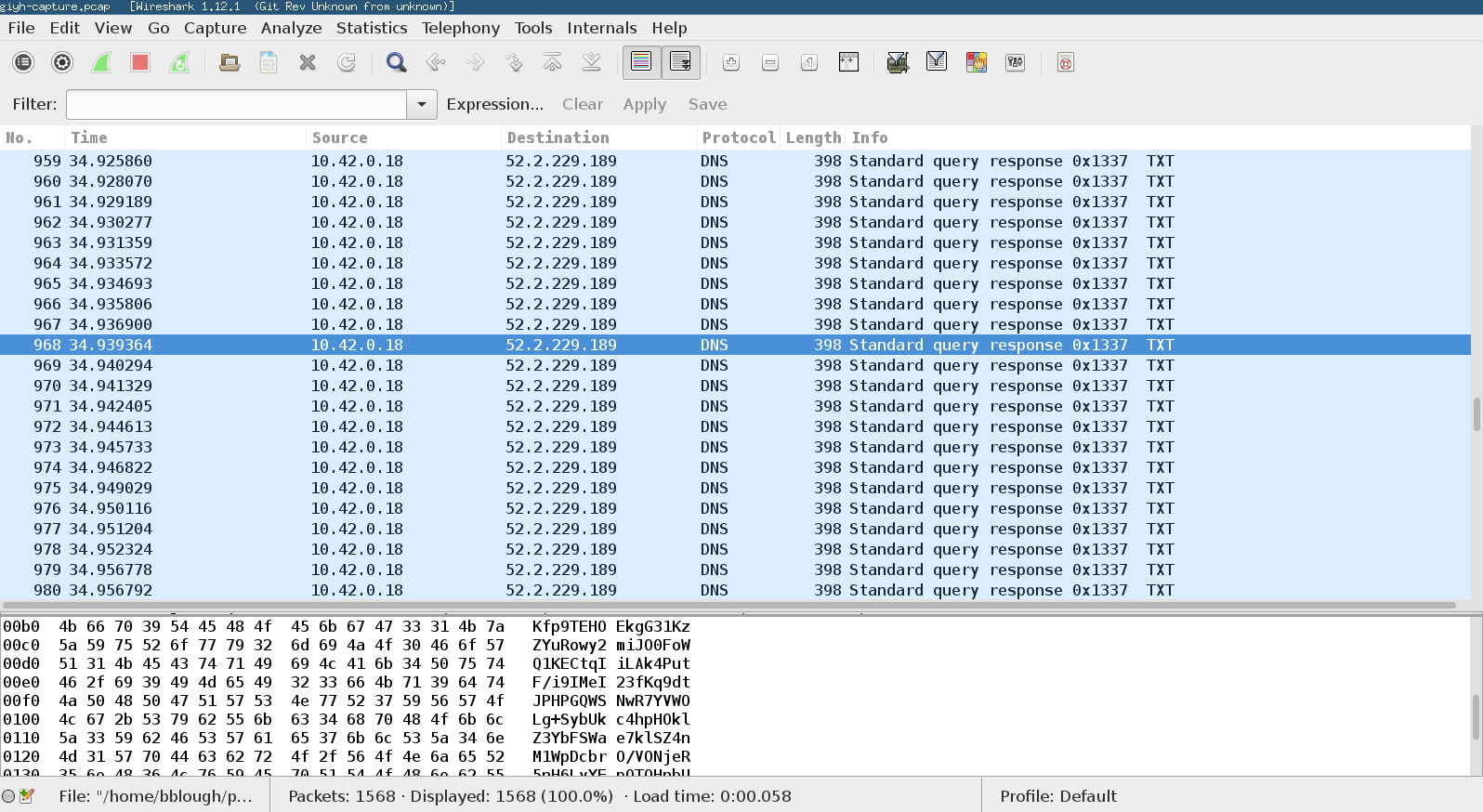
Some basic scripting with Scapy made extracting the relevant information from the traffic pretty straightforward. The results showed commands being executed on the Gnome via the C&C channel, and an image taken by the Gnome's camera being sent back to the controlling system.
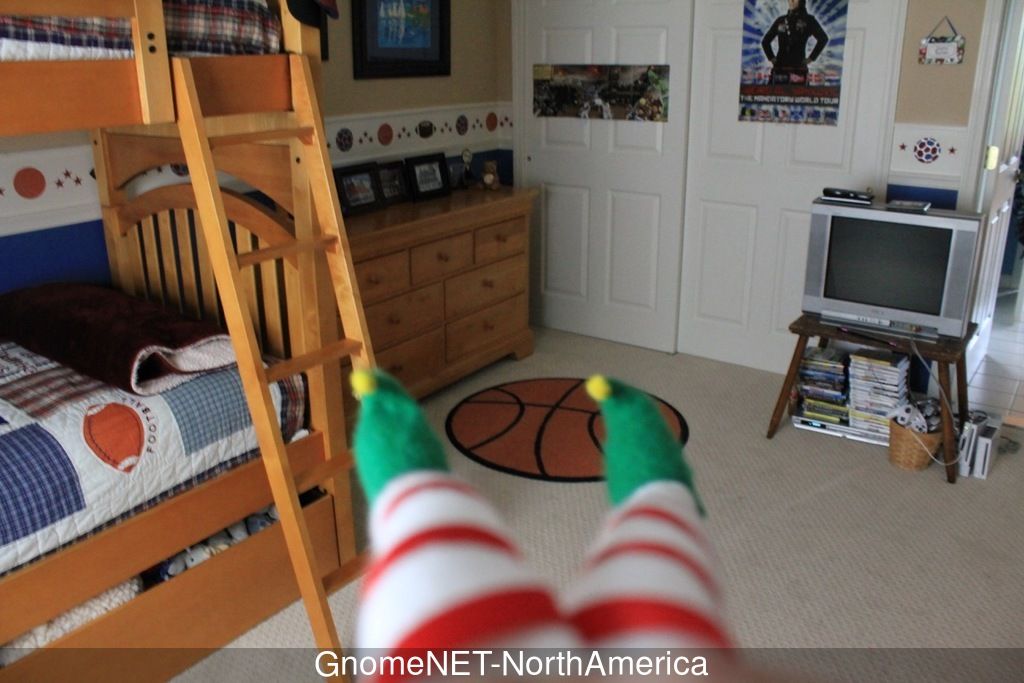
Part 2 - The firmware dump
The provided firmware file contained a squashfs filesystem that was easily unpacked by binwalk.
DECIMAL HEXADECIMAL DESCRIPTION
--------------------------------------------------------------------------------
0 0x0 PEM certificate
1809 0x711 ELF 32-bit LSB shared object, ARM, version 1 (SYSV)
168803 0x29363 Squashfs filesystem, little endian, version 4.0, compression:gzip, size: 17376149 bytes, 4866 inodes, blocksize:
131072 bytes, created: Tue Dec 8 13:47:32 2015
The firmware was based on OpenWRT and was compiled for ARM. Customized for use in the Gnome, it contained a Node.js web application, a MongoDB instance, and Gnome-specific programs sgdnsc2 and sgstatd.
An examination of the database yielded application credentials stored in plaintext, including credentials for a regular user account, as well as an admin account.
Analysis of the web application code yielded several vulnerabilities that could be used to compromise the SuperGnomes. However, much of the relevant code was commented out, so the vulnerabilities present in a specific SuperGnome would depend on which version of the code it was running.
Also found in the firmware was the IP address of the first SuperGnome.
Part 3 - Finding SuperGnomes
Accessing the first SuperGnome via a web browser (using the admin credentials found in the firmware) indicated that there were a total of five SuperGnomes. Plugging some Gnome-specific information into Shodan quickly led to the other four, all scattered around the world.
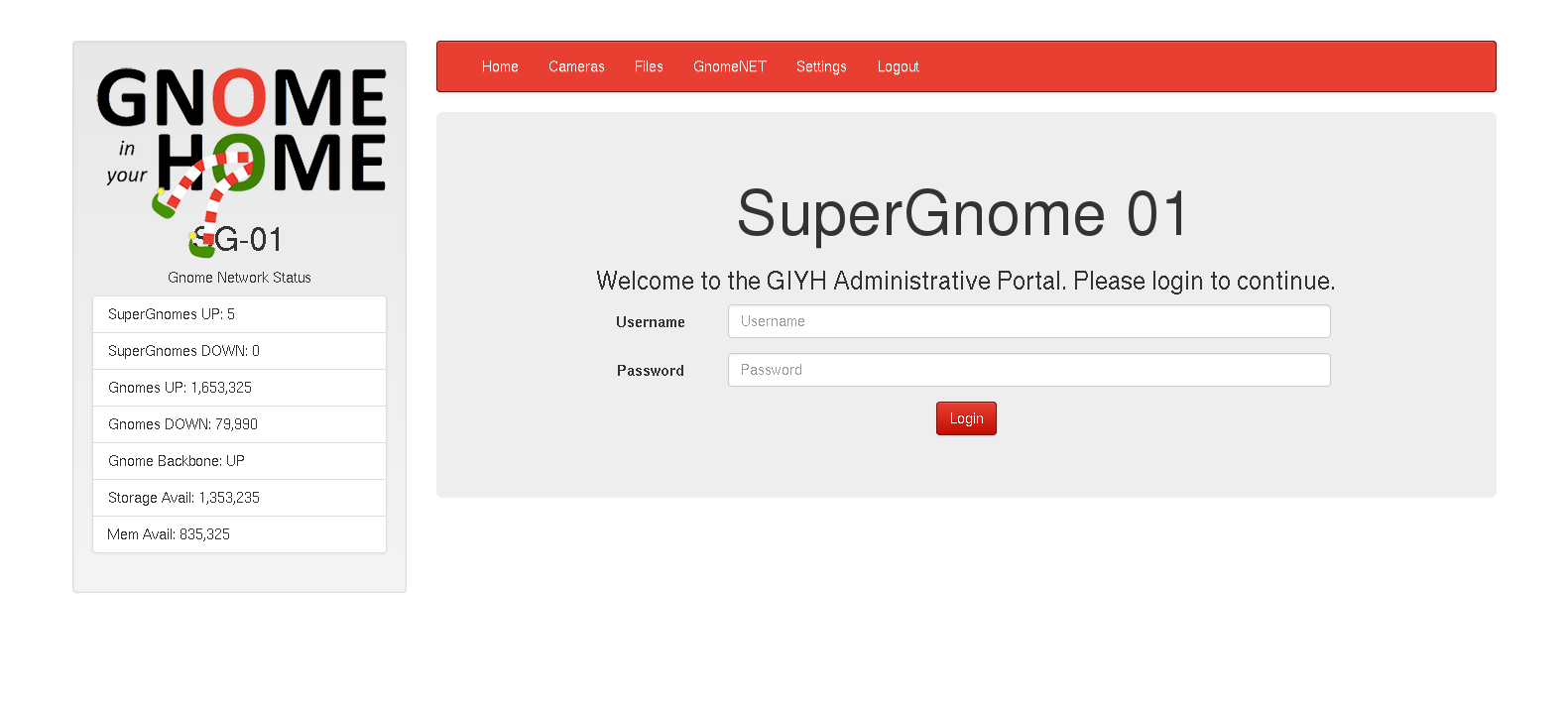
Part 4 - Hacking SuperGnomes
SG-01: For SG-01, no exploits were needed, however. The admin credentials found in the firmware were enough to access the needed files, including the gnome.conf, another packet capture, some fuzzy camera images, messages from "GnomeNet", and a zip file containing the sgstatd program source code.
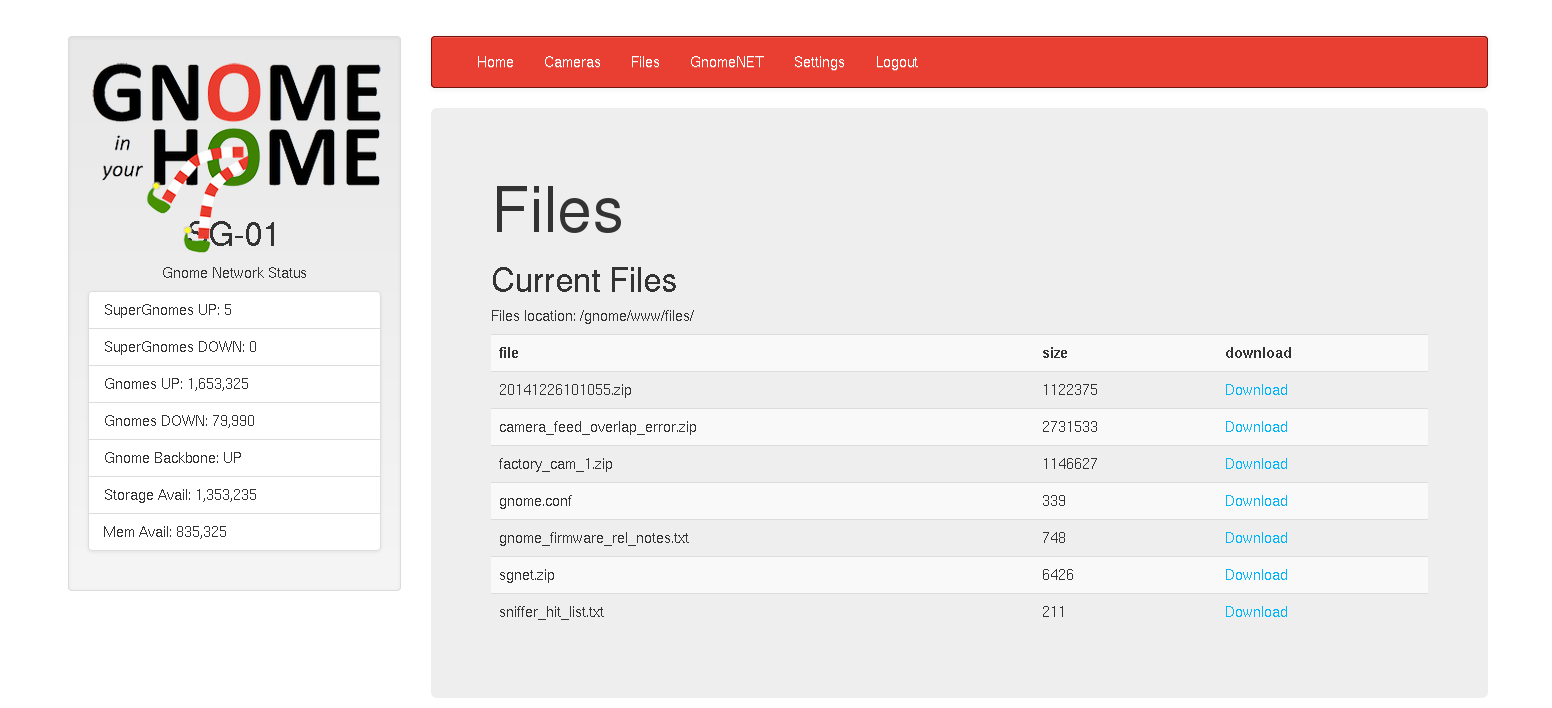
The packet capture contained a complete SMTP session, from which the email message could be read. The email contained plot details, and a rough diagram of the Gnome surveillance network architecture.
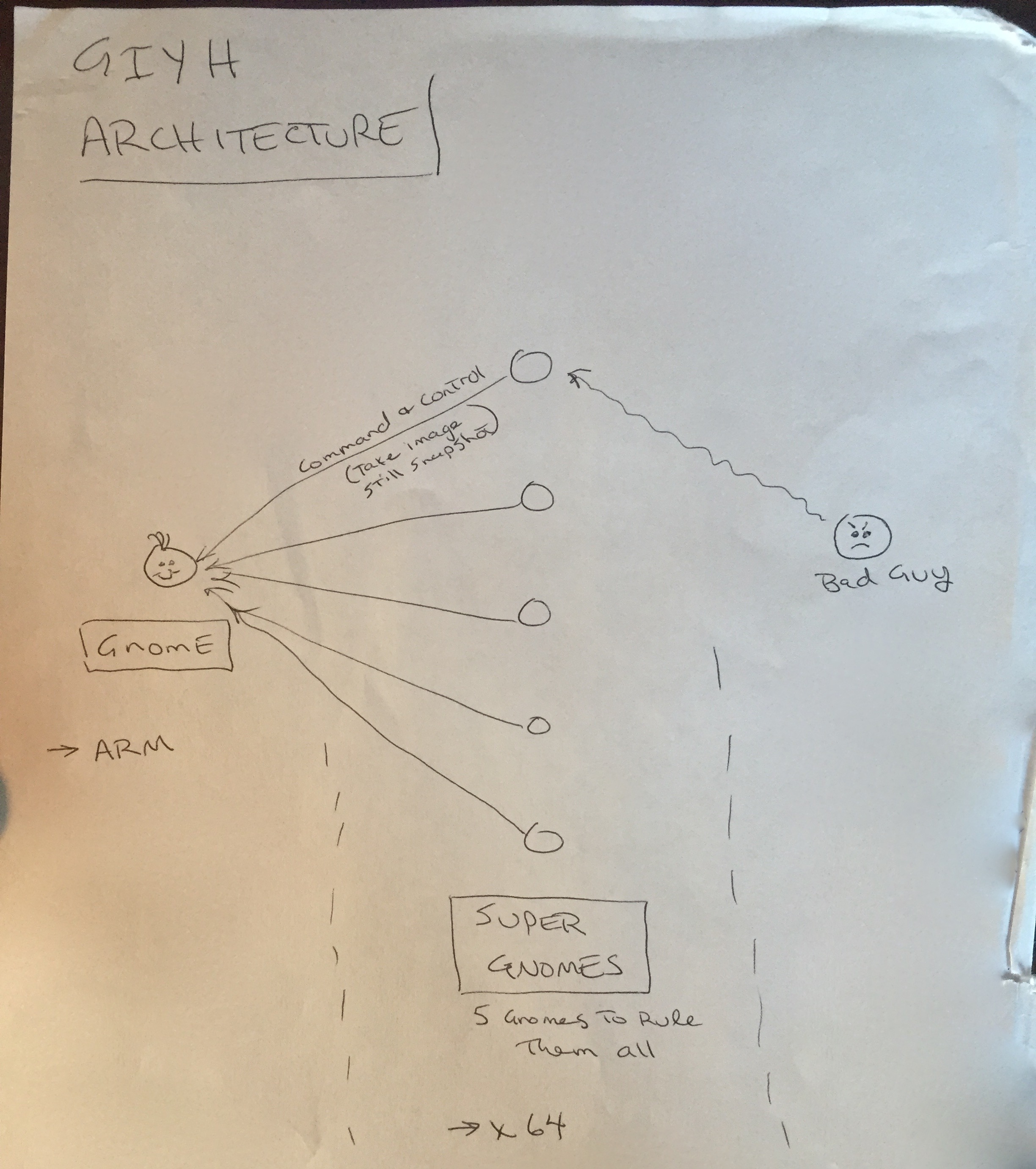
Based on the GnomeNet messages, the fuzzy camera images were evidence of a software error that caused several camera images to be XORed together. Conveniently, all of the cameras had been shut off except for the one in the boss' office, so XORing all of the disabled factory camera images with the garbled image should produce an image of the boss' office (and maybe even the boss).
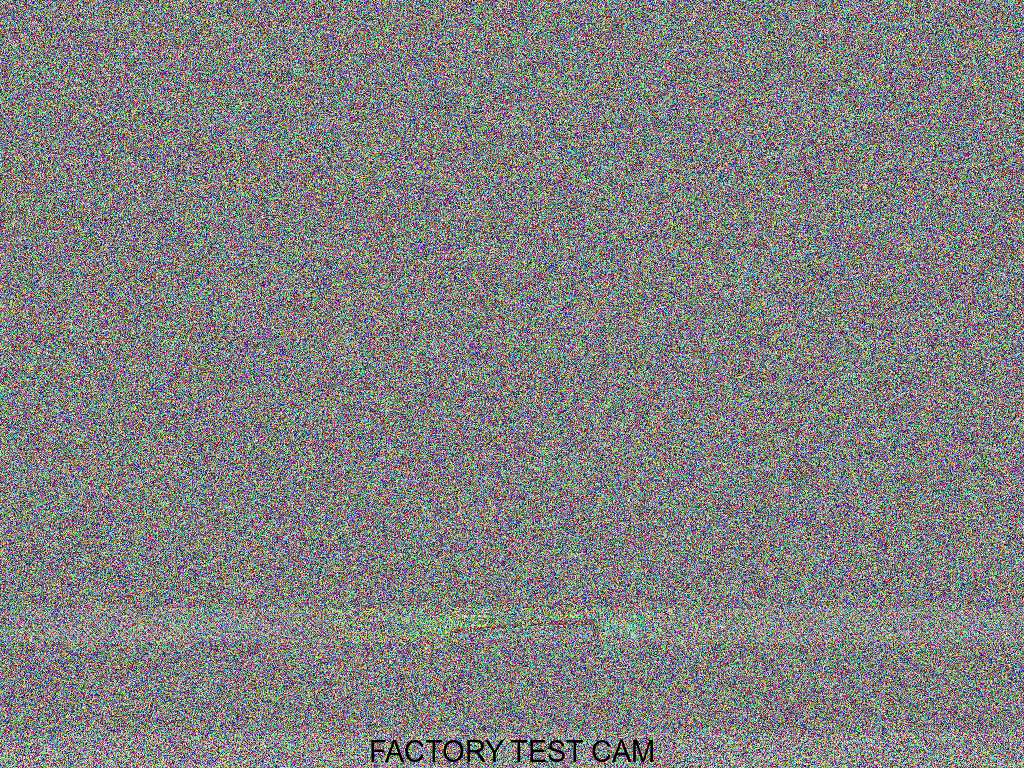
The sgstatd source code proved useful, since analyzing the source yielded another vulnerability that could be exploited on the SuperGnomes.
SG-02: While it was possible to log into SG-02 using the known credentials, file download was disabled. However, the web application's camera image viewer contained Local File Include and Path Traversal vulnerabilities, with the caveat that it also contained an extension check to ensure that only files with a .png extension could be viewed/downloaded. Fortunately, it was possible to bypass this by using the settings upload function to create a subdirectory named .png, and then crafting the path traversal to include our .png directory in the path when specifying the local file to include.


With this, it was possible to download the gnome.conf, another packet capture, and another factory camera image.
The packet capture contained another SMTP session. In this email, the Gnome hardware order was being discussed, including ARM-based systems, WiFi adapters, and other hardware.
SG-03: On SG-03, the admin credentials used previously did not work at all -- it wasn't even possible to log in with them. The user credentials worked, but did not have access to anything useful. However, the authentication routine was vulnerable to NoSQL injection. Using Burp Suite to modify form submissions, it was possible to pass JavaScript into the login form, affect the DB query, and trick the system in to authenticating as admin even without the password.
POST / HTTP/1.1
Host: 52.64.191.71
User-Agent: Mozilla/5.0 (X11; Linux i686; rv:38.0) Gecko/20100101 Firefox/38.0 Iceweasel/38.4.0
Accept: text/html,application/xhtml+xml,application/xml;q=0.9,*/*;q=0.8
Accept-Language: en-US,en;q=0.5
Accept-Encoding: gzip, deflate
DNT: 1
Referer: http://52.64.191.71/
Cookie: sessionid=WkuIcJkXMuOi0Jpa7bSV
Connection: close
Content-Type: application/json
Content-Length: 68
{
"username": {"$eq": "admin"},
"password": {"$gt": ""}
}
Once logged in, it was possible to download the gnome.conf, another packet capture, and another factory camera image, all directly from the file download page.
The packet capture contained another SMTP session. In this email, the evil plot was revealed - to dress like Santa Claus and rob houses on Christmas Eve!
From: "c" <c@atnascorp.com>
To: <burglerlackeys@atnascorp.com>
Subject: All Systems Go for Dec 24, 2015
Date: Tue, 1 Dec 2015 11:33:56 -0500
Message-ID: <005501d12c56$12bf6dc0$383e4940$@atnascorp.com>
MIME-Version: 1.0
Content-Type: multipart/alternative;
boundary="----=_NextPart_000_0056_01D12C2C.29E9B3E0"
X-Mailer: Microsoft Outlook 15.0
Thread-Index: AdEsVeghqBzCbZs7SUyM8aoCkrx6Ow==
Content-Language: en-us
This is a multipart message in MIME format.
------=_NextPart_000_0056_01D12C2C.29E9B3E0
Content-Type: text/plain;
charset="us-ascii"
Content-Transfer-Encoding: 7bit
My Burgling Friends,
Our long-running plan is nearly complete, and I'm writing to share the date
when your thieving will commence! On the morning of December 24, 2015, each
individual burglar on this email list will receive a detailed itinerary of
specific houses and an inventory of items to steal from each house, along
with still photos of where to locate each item. The message will also
include a specific path optimized for you to hit your assigned houses
quickly and efficiently the night of December 24, 2015 after dark.
Further, we've selected the items to steal based on a detailed analysis of
what commands the highest prices on the hot-items open market. I caution
you - steal only the items included on the list. DO NOT waste time grabbing
anything else from a house. There's no sense whatsoever grabbing crumbs too
small for a mouse!
As to the details of the plan, remember to wear the Santa suit we provided
you, and bring the extra large bag for all your stolen goods.
If any children observe you in their houses that night, remember to tell
them that you are actually "Santy Claus", and that you need to send the
specific items you are taking to your workshop for repair. Describe it in a
very friendly manner, get the child a drink of water, pat him or her on the
head, and send the little moppet back to bed. Then, finish the deed, and
get out of there. It's all quite simple - go to each house, grab the loot,
and return it to the designated drop-off area so we can resell it. And,
above all, avoid Mount Crumpit!
As we agreed, we'll split the proceeds from our sale 50-50 with each
burglar.
Oh, and I've heard that many of you are asking where the name ATNAS comes
from. Why, it's reverse SANTA, of course. Instead of bringing presents on
Christmas, we'll be stealing them!
Thank you for your partnership in this endeavor.
Signed:
-CLW
President and CEO of ATNAS Corporation
SG-04: The admin credentials found in the firmware allowed login to SG-04, but as expected, file download did not work. However, file upload was enabled, and was vulnerable to JavaScript injection.
Once again using Burp Suite, it was possible to modify form submissions to include malicious JavaScript. In this case, any JavaScript included in the "postproc" form field would be executed on the server, making it straightforward to display or download any files needed.
res.end(require('fs').readFileSync('files/gnome.conf'))
require('fs').readFileSync('files/factory_cam_4.zip').toString('base64')
Files obtained from SG-04 were its gnome.conf, another packet capture, and another factory camera image.
The packet capture included another SMTP session. In this email, the CEO discusses her dislike of Christmas, her evil plot, and her motivations with her therapist. Based on her signature, it becomes apparent that she is none other than Cindy Lou Who, of "How the Grinch Stole Christmas" fame.
SG-05: While the found credentials allowed login to SG-05, none of the upload or download functions were active, nor were any of the previous exploits successful. However, a port scan of SG-05 showed that port 4242 was open. Based on analysis of the sgstatd source code, SG-05 was likely running sgstatd on port 4242, and was therefore likely to be vulnerable.

The earlier analysis of sgstatd revealed a hidden command whose code contained a buffer size mismatch that could lead to a buffer overflow and arbitrary code execution.
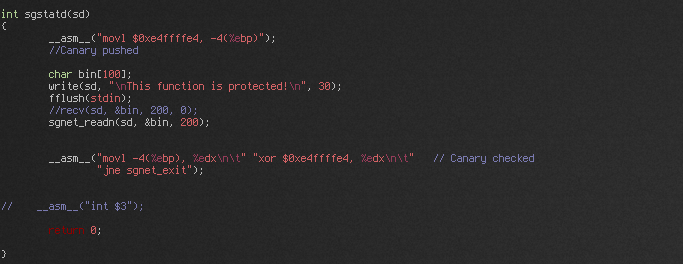
As an attempt to mitigate buffer overflows, sgstatd employs a stack canary for the vulnerable function. However, the canary was a constant, so bypassing it was as simple as ensuring that the canary value was re-copied to the correct place as part of the exploit payload.
Developing the exploit was mostly straightforward, thanks to some hints from the challenge instructions. The first hint indicated that stack execution protection (NX/DEP) was not being used, and checking the sgstatd binary from the firmware confirmed this. Another hint indicated that ASLR was being used, and that it might be wise to use a "jmp *esp" ROP gadget to bypass it.
Armed with this information, it was simply a matter of developing the payload, finding the ROP gadget offsets, etc. The sgstatd source could be compiled with symbols and debugged, so much of this was simplified. In addition, the sgstatd binary from the firmware was compiled for x86 instead of ARM, so that was useful for finding ROP gadget offsets for the target version of the binary.
The first shellcode attempted was a reverse shell using netcat. The payload executed successfully on the local system against the locally compiled binary, and also the firmware binary. However, launching it against the target failed. At the time, it seemed that a firewall was blocking outbound connections, but this turned out not to be the case. Eventually the problem was tracked down to an issue with the shellcode itself.
Since at the time it seemed like there was a firewall problem, a different approach was tried. Instead of using netcat, the payload was rewritten to reuse the socket descriptor and open a shell over the existing connection. This was made more difficult by sgstatd using randomized socket descriptors. Frequently, this is handled by randomly trying to "brute-force" the socket descriptor, and eventually succeeding. However, since the socket descriptor was passed as an argument to an earlier function call, the value was still on the stack. And since the function calls (and therefore stack layout) are fairly consistent, it was simple enough to find the descriptor on the stack with the debugger, calculate the offset relative to EBP/ESP, and then have the payload retrieve the value using the offset.

All of this worked both locally and against the target, yielding a shell and the necessary files. Files obtained were SG-05's gnome.conf, another packet capture, and another factory camera image.
The packet capture contained an IMAP mail session. In this email, the Grinch was apologizing to Cindy Lou Who for what happened in the past.
Part 5 - Attribution
As previously discovered in the email, the culprit is Cindy Lou Who, from "How the Grinch Stole Christmas", and her plot was to steal from families on Christmas Eve using burglars dressed as Santa Claus.
Additionally, with all 5 factory camera images, it was possible to XOR them together with the garbled camera image, producing an image of Cindy Lou Who, age 62, sitting at her desk.
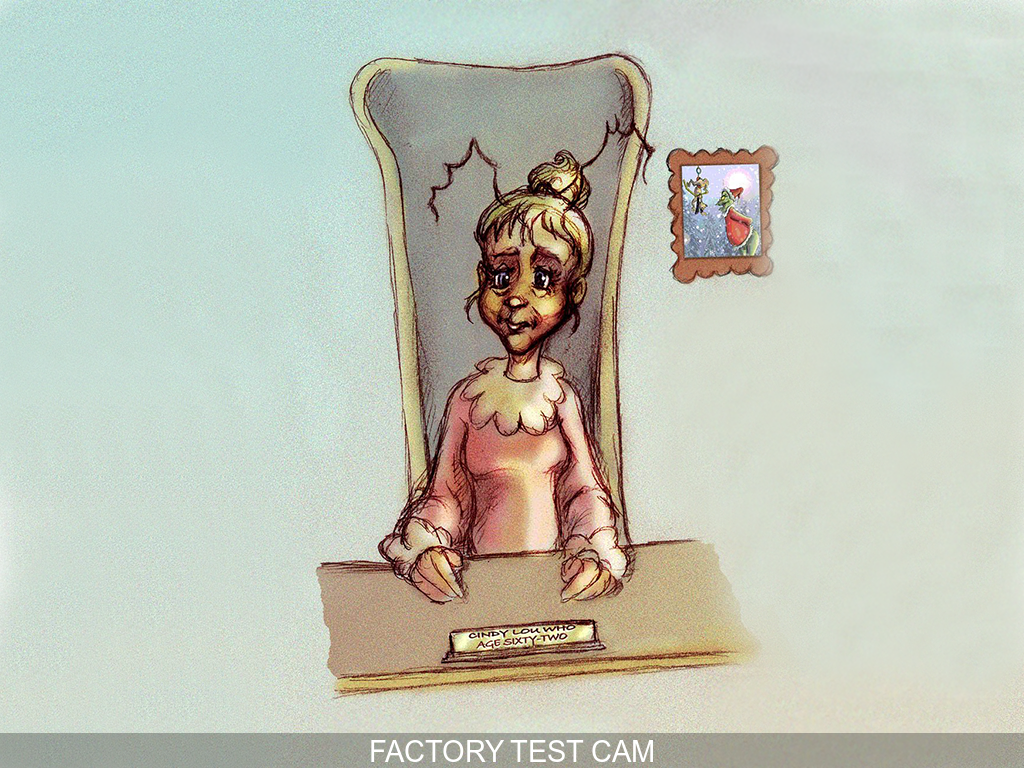
Comments
Overall, this was a very enjoyable challenge. Not only did it require a good mix of skills, it was a good opportunity to brush up on old skills and pick up some new skills at the same time. It also had a fun theme.
Kudos to the folks at SANS that developed this. They did a great job!